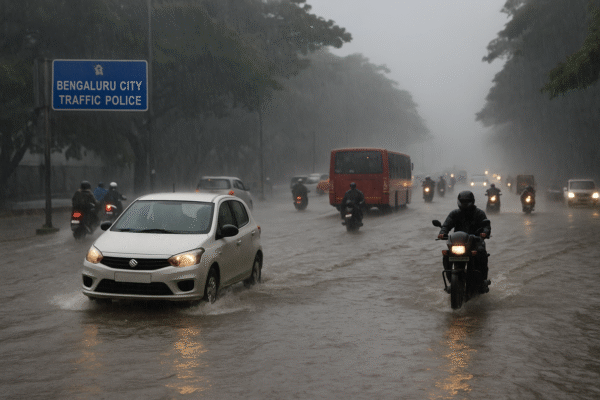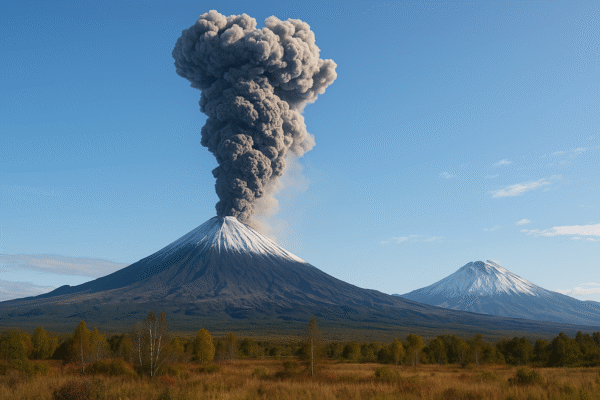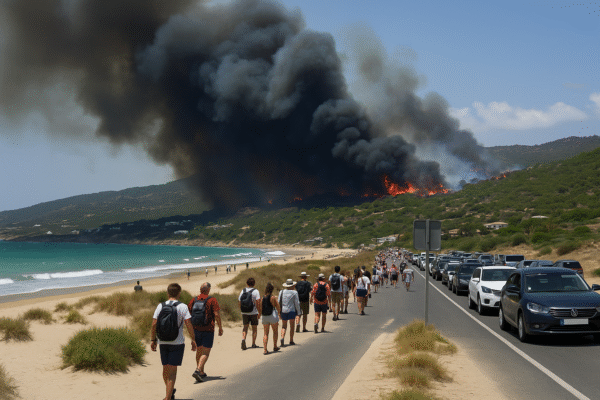Spain’s renowned southern coastal town of Tarifa, a hotspot for summer tourism and kite surfing, is facing a dire environmental emergency as a rapidly advancing wildfire forces mass evacuations of residents and holidaymakers. The blaze, intensified by gusty Levante winds and an incoming extreme heatwave, is rapidly consuming natural landscapes and threatening popular seaside resorts in Andalusia, prompting an urgent regional and national emergency response.
The fire broke out near Torre de la Peña, a mountainous area surrounded by natural parks and campgrounds, and has since moved quickly toward the coastline. The blaze is particularly dangerous due to its proximity to both residential zones and tourist campsites, notably those popular with international travelers seeking Tarifa’s wind-swept beaches.
Tourists and Locals Evacuated from Tarifa Amidst Emergency Measures
As of early August, over two miles of coastline between La Peña and Casas de Porros have been evacuated. The scenic N-340 highway, which runs along the southern coast and serves as a major access route to Tarifa, has been temporarily shut down to allow emergency vehicles uninterrupted access and to prevent civilian traffic from entering high-risk areas.
All accommodations within the evacuation zone, including hotels, bars, restaurants, and beachfront resorts, have been cleared out. According to INFOCA, the Andalusian Forest Fire Extinction Service, aircraft and ground crews are working tirelessly to suppress the flames, with additional firefighting brigades deployed from neighboring provinces.
Thick plumes of smoke have enveloped the sky over Cadiz province, prompting air quality alerts and further safety precautions. Beaches once filled with sunbathers and surfers now lie empty, as emergency services continue to push back the inferno from reaching deeper into populated tourist corridors.
Incoming Heatwave Threatens to Escalate Fire Risk in Andalusia
The Spanish State Meteorological Agency (AEMET) has issued amber-level heat alerts for much of Andalusia, including Cádiz, Seville, and Córdoba. Temperatures are expected to soar between 38°C to 42°C (100°F to 108°F) this week, significantly complicating firefighting operations.
Such conditions create the perfect storm: high temperatures, dry brush, and strong inland winds combine to form an extreme fire risk index. According to AEMET, the heatwave is expected to last through the weekend, further stressing both natural resources and emergency infrastructure.
As part of national emergency planning, Spain’s Ministry for the Ecological Transition has issued renewed guidance on wildfire prevention and is coordinating with local municipalities, civil protection units, and tourism authorities to ensure the safety of all citizens and visitors.
The Economic Toll: Summer Tourism Disrupted Across Costa de la Luz
The wildfires come during Spain’s peak summer tourism season, when thousands flock to the Costa de la Luz for its golden beaches, vibrant culture, and natural parks. Tarifa alone receives over 100,000 visitors each summer, making tourism the economic lifeblood of the region.
The forced evacuation and closure of hospitality businesses are expected to have severe short-term economic impacts, particularly for small, locally owned establishments that depend on seasonal income. Tour operators and travel agencies have issued advisories, while many tourists have had to reroute or cancel their plans.
Regional officials have urged travelers to stay informed via official channels, including the INFOCA wildfire map, and the Spanish Civil Protection emergency alert system. Tourists are advised to contact their embassies or travel providers if they are affected by the evacuations.
Spain’s Growing Wildfire Crisis: A Wake-Up Call on Climate Change
Spain, along with much of southern Europe, has been experiencing an increase in wildfire frequency and intensity over recent years, driven by climate change, prolonged droughts, and rising temperatures. According to EU Copernicus climate data, Spain recorded over 1,500 wildfires in 2024, burning more than 160,000 hectares of land.
Environmental groups are calling for stronger investment in fire prevention infrastructure, forest management, and climate resilience in tourist-heavy zones like Andalusia. The current crisis underscores the growing need for coordinated environmental strategies and disaster preparedness in light of more frequent extreme weather events.
Government and Local Authorities Act Swiftly
Spain’s Ministry of the Interior and Andalusian regional government have activated level-two emergency protocols and are working with local fire brigades, forest rangers, and health services to contain the situation. Extra water-bombing helicopters have been deployed from bases in Seville and Málaga, and backup crews from as far as Extremadura have been called in.
Emergency accommodation for evacuees has been set up in Algeciras and Vejer de la Frontera, with priority given to the elderly, children, and tourists without access to transport.
Safety First: Travel Tips for Tourists in Southern Spain
Authorities are reminding all travelers in Andalusia to:
- Follow evacuation instructions and heed all local advisories.
- Check AEMET and INFOCA for up-to-date weather and fire information.
- Avoid traveling into or near forested areas.
- Prepare emergency kits with essentials like water, masks, chargers, and identification.
- Monitor official social media from Turismo Andalucía, Protección Civil, and local police.
Conclusion: Hope Amidst the Smoke
As firefighters battle the blaze and Spain braces for an oppressive heatwave, the strength of community response and government coordination offers a glimmer of hope. With proper caution and timely evacuation measures, human casualties have so far been avoided.
The wildfire near Tarifa may have temporarily halted summer fun, but with recovery efforts underway and safety as the top priority, Andalusia will soon rise again as the radiant jewel of southern Spain’s tourism.
For more travel news like this, keep reading Global Travel Wire















